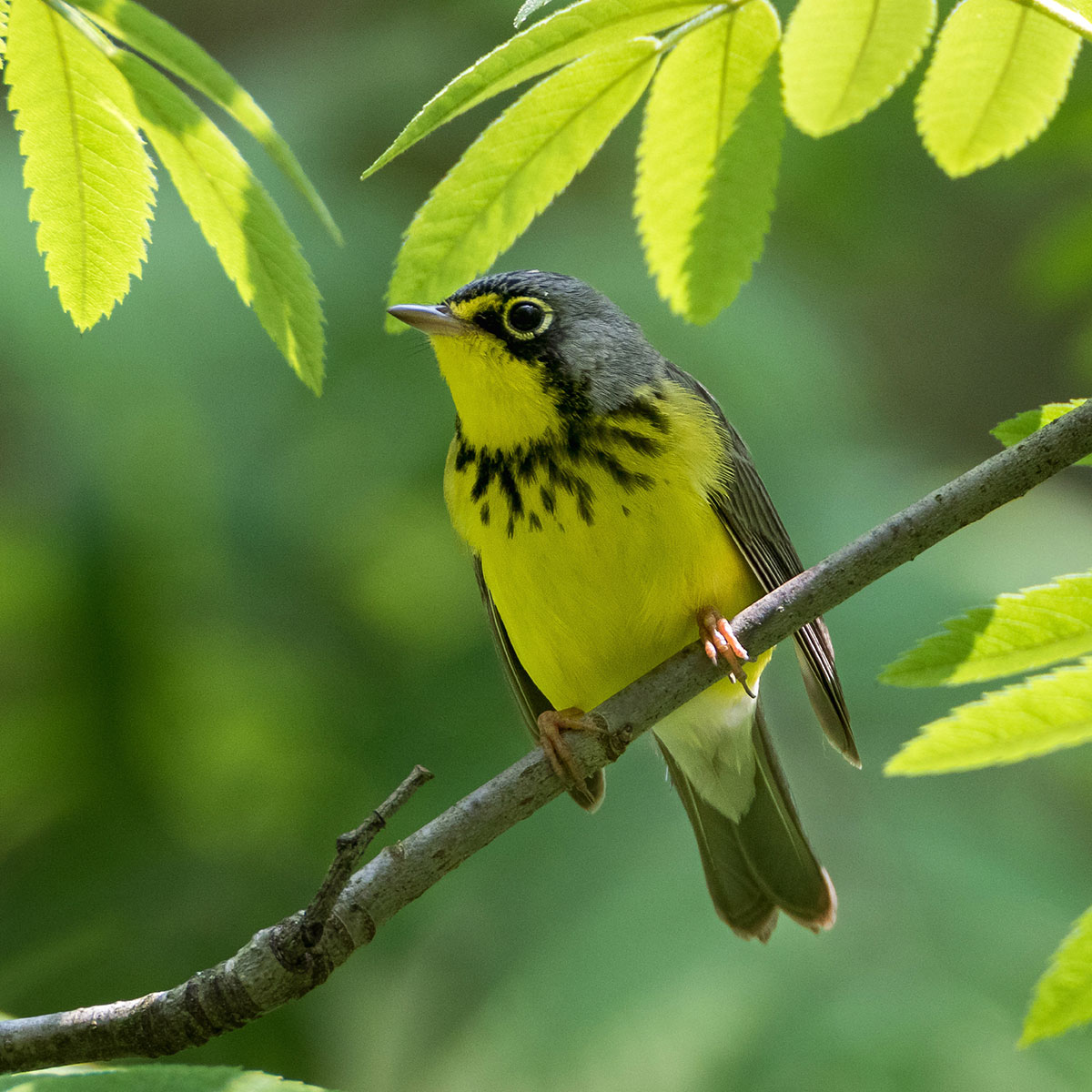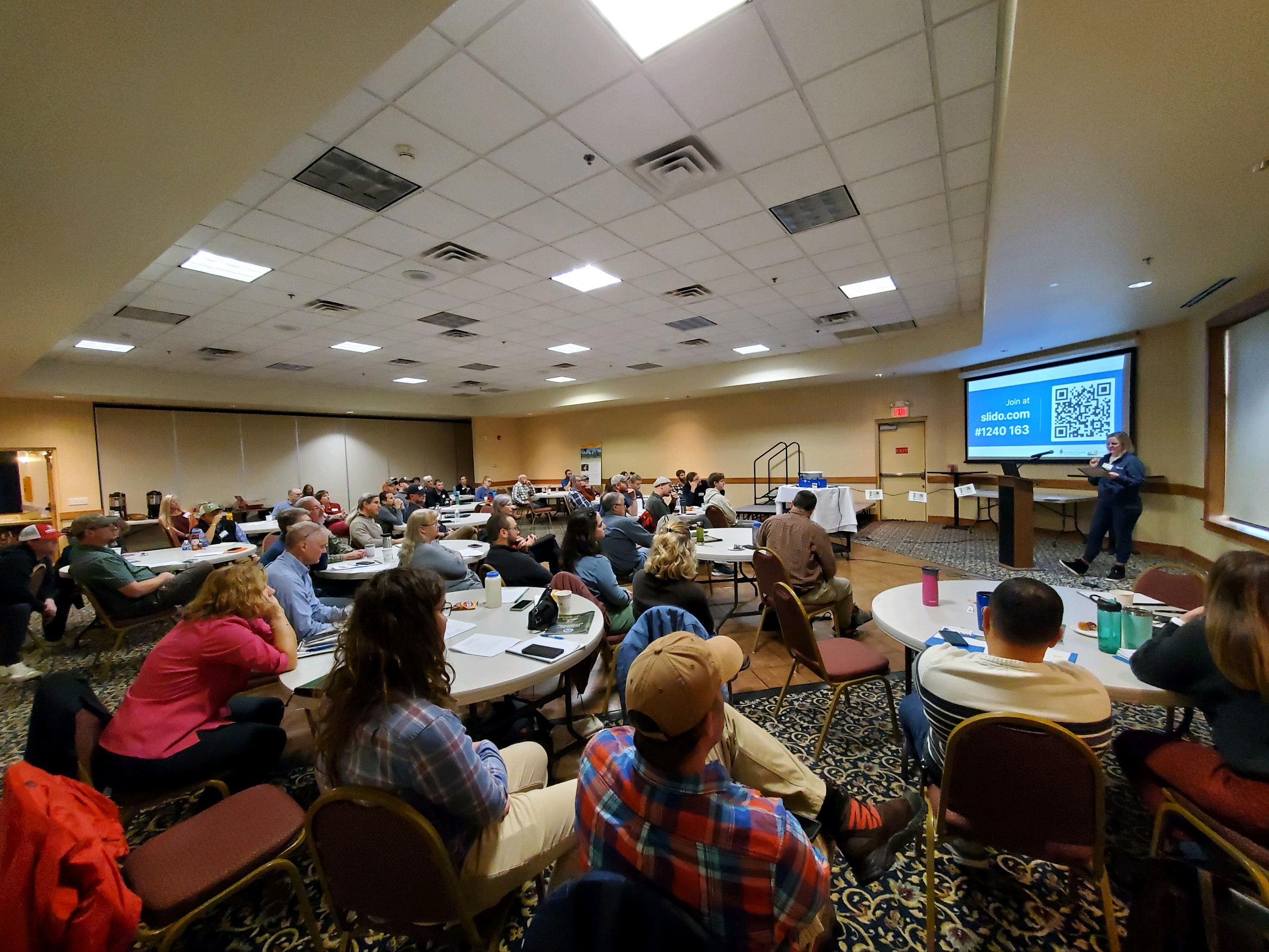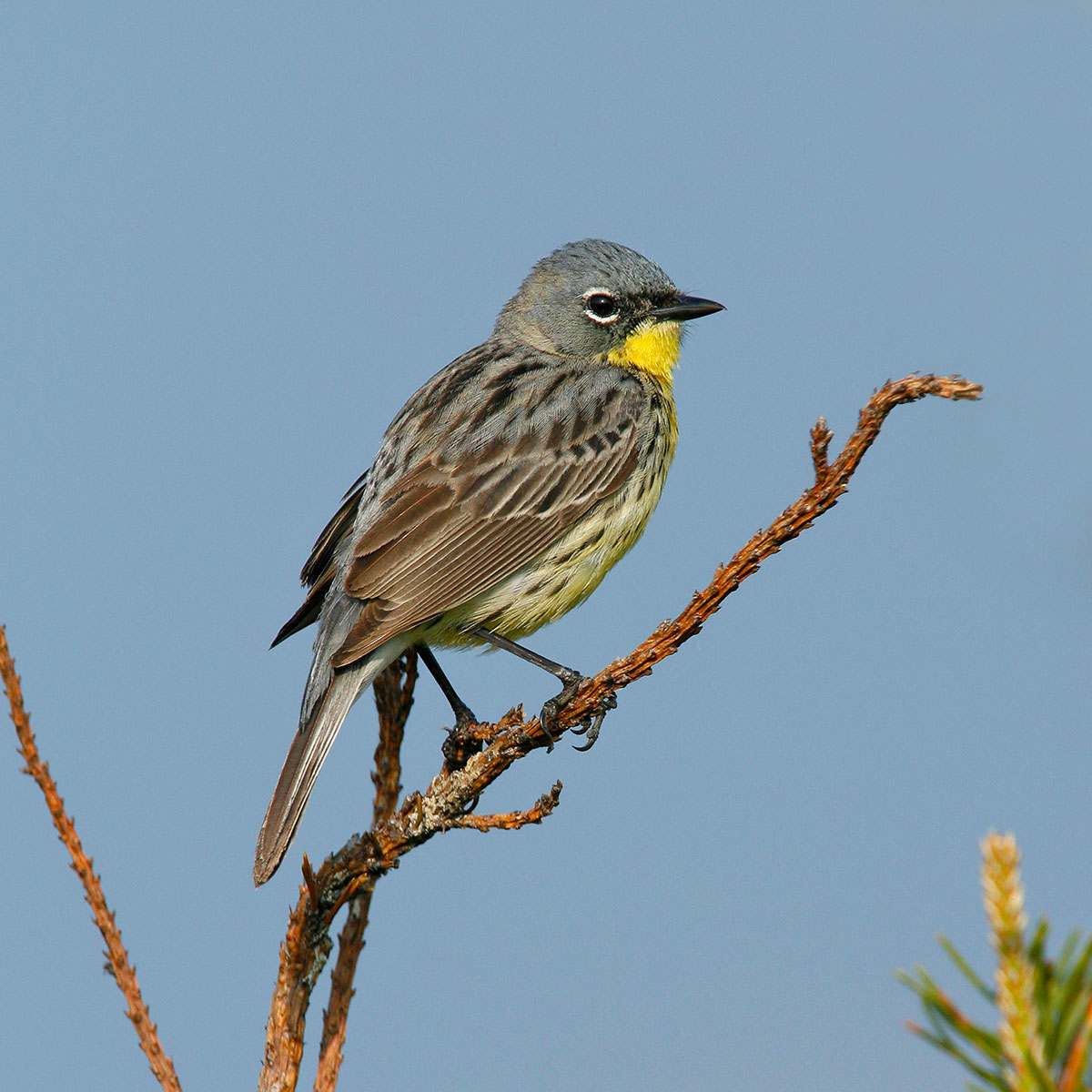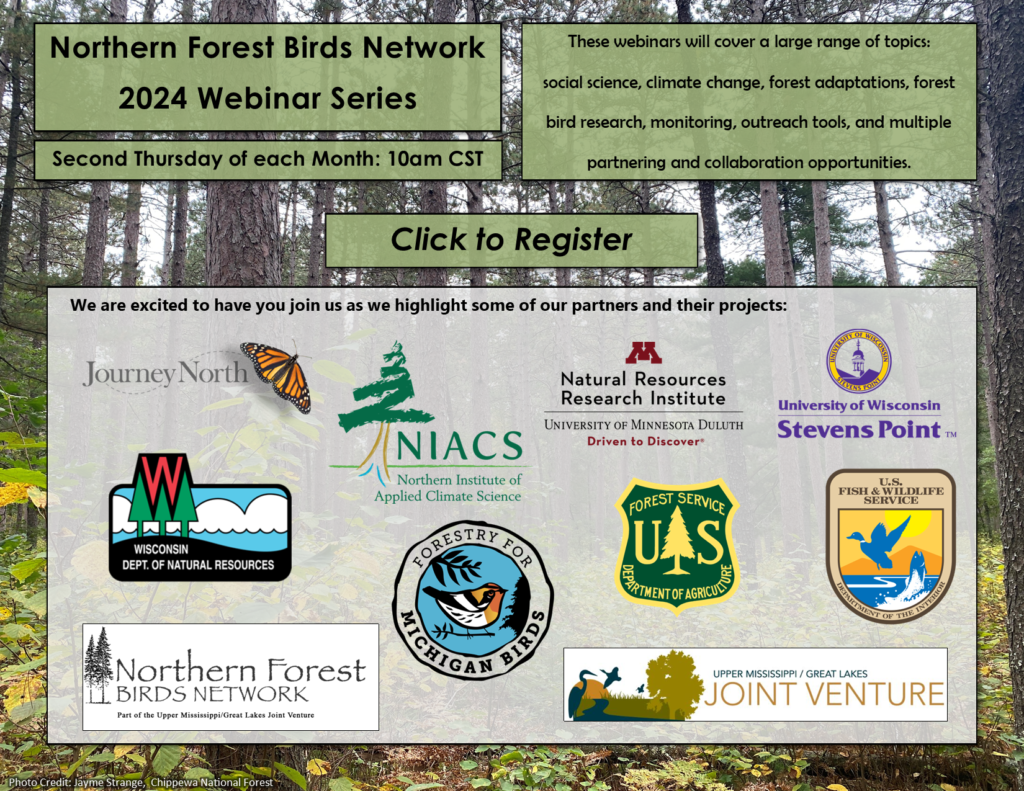Northern Forest Birds Network
Bird conservation in the northern forests of Michigan, Minnesota, and Wisconsin has received increasing attention in the last decade in response to a great need for improved coordination of monitoring and other conservation activities for northern forest birds across the boreal hardwood transition zone (Bird Conservation Region 12).
The Northern Forest Birds Network formed in 2013 and has since made steady progress towards identifying a shared vision, translating that vision into clear goals, engaging a robust network of partners, and expanding its focus from coordinated monitoring and data management to also integrating science-based needs of forest birds with land management activities.
In 2018, the Network transitioned from operating within the Midwest Coordinated Bird Monitoring Partnership to serving within the Upper Mississippi and Great Lakes Joint Venture partnership.
Vision: Our leadership and guidance in monitoring, research, and management actions ensure thriving, diverse northern forest bird communities across the U.S. portion of Bird Conservation Region 12.

Canada Warblers can often be seen hopping between understory trees while cocking their tails and flipping their wings.
Goals:
- Northern forest bird conservation and research organizations actively share information about the biology, ecology, and status of northern forest birds.
- Northern forest bird conservation organizations coordinate and collaborate to ensure that the conservation needs of northern forest birds are addressed.
- The best available science is used to assess the status and productivity of northern forest birds.
- Monitoring and research data are used to inform and evaluate management practices, which are used to deliver conservation actions that benefit northern forest birds.
Steering Committee
The Steering Committee serves as an advisory body by providing guidance, leadership, support, and oversight to the Northern Forest Birds Network. It ensures that the Network’s projects and ideas align with its original vision and goal statements and ultimately benefit northern forest birds in Bird Conservation Region 12.
Committee Members
- Ryan Brady, Wisconsin Department of Natural Resources (WI)
- Peter Dieser, American Bird Conservancy (MN)
- Dave Fehringer, Eastwood Forests, LLC (MI)
- Andrew Forbes, U.S. Fish & Wildlife Service (MN)
- Ted Gostomski, U.S. National Park Service (WI)
- Alexis Grinde, Natural Resources Research Institute (MN)
- Michael Lynch, Forest Stewards Guild (MN)
- Michael Paling, American Bird Conservancy (MI)
- Dave Grosshuesch, U.S. Forest Service (MN)
Questions or comments?
Northern Forest Birds Network
“Our leadership and guidance in monitoring, research, and management actions ensure thriving, diverse northern forest bird communities across the U.S. portion of Bird Conservation Region 12.”
Products
Any line of work calls for prioritizing limited resources where they are needed most. In the bird conservation world, that often means focusing effort on certain species and habitats or incorporating best management practices for these targets into projects with other primary goals. At our 2018 workshop, attendees expressed desire for a consolidated list of forest bird species that conservationists, land managers, and foresters could rally around for planning efforts or conducting on-the-ground activities. To meet that need, the Northern Forest Bird Network steering committee is pleased to announce the Priority Forest Bird Species-Habitat Matrix.
The Priority Forest Bird Species-Habitat Matrix identifies as conservation targets both common and uncommon species that are emblematic of the avian community in Bird Conservation Region 12 (BCR 12). Although the U.S. portion of BCR 12 lies at the southern edge of the breeding range for most of these species, they are good indicators of forest health, and their populations are generally declining in our region. We recognize that some or even many practitioners approach their work from a habitat perspective, so this matrix identifies the habitat needs of the target species (i.e., what’s necessary and ideal). We hope these features provide necessary and useful guidance.
2023 Conference Proceedings and Presentations
On October 17-18, 2023, over 60 individuals from 27 different organizations joined together in Ashland, Wisconsin, to discuss best management practices (BMPs) for forest bird habitats, and climate change considerations for forest bird conservation. A conference summary can be found on our news page.
Throughout the conference, questions from the audience led to insightful discussions, especially during panel question and answer sessions featuring all the day’s presenters. The PowerPoints that were presented at the conference are linked below.
- Northern Forest Birds Network News – Ryan Brady (Wisconsin DNR)
- Why it Matters? 3 Billion Birds Lost – Alexis Grinde (Natural Resources Research Institute, University of Minnesota-Duluth)
- Forestry for Birds soars across Michigan – Michael Paling (American Bird Conservancy)
- Forestry for Birds takes flight in Minnesota – Christian Nelson (Forest Stewards Guild)
- Case examples of managing priority species & habitats
- Golden-winged Warbler Habitat in Deciduous Forest and Brushland Cover Types – Peter Dieser (American Bird Conservancy)
- Expanding the central breeding range of Kirtland’s Warbler – Brianne Boan (U.S. Forest Service, Ottawa National Forest)
- Connecticut Warblers in upland jack pine – Ryan Brady
- Connecticut Warblers & other boreal species in lowland conifers – Josh Bednar (Natural Resources Research Institute, University of Minnesota-Duluth)
- Mid to late successional habitat structure – Josh Bednar
- Importance of cavity trees to woodpeckers and other forest birds – Mike North (Minnesota DNR)
- Great Lakes Oak Ecosystems and Managing an Urban Greenspace as Bird Habitat – Jordan Winkenbach (American Bird Conservancy)
- Forestry for Birds Breakout Sessions – lead by Michael Paling
- Climate Change and Northern Forests: A Review – Brad Hutnik (Wisconsin DNR)
- Impacts of climate change on forest birds – Alexis Grinde
- Considering landscape resilience – Matt Dallman (The Nature Conservancy)
- NIACS Climate Change Adaptation Workbook & Regional Resources – Linda Parker (U.S. Forest Service, Wisconsin Initiative on Climate Change Impacts)
- Applying adaption principles: A case study of the Caroline Lake Preserve – Matt Dallman

Attendees in Ashland, WI discussing climate change adaptations at the “Forestry for Birds in a Changing Climate” conference.
2018 Workshop Proceedings and Presentations
In April 2018, we organized a workshop to achieve the following objectives: 1) re-engage and provide updates to the broader Working Group community, 2) kick-start several projects, and 3) provide training on the Midwest Avian Data Center. Over 50 participants representing 20 organizations attended the event in Ashland, Wisconsin. Individual presentations and a comprehensive summary of this workshop are available for download below:
- Comprehensive Workshop Proceedings
- History, Overview, and Update on BCR 12 Working Group – Erin Giese and Katie Koch
- Mission of and Integration with the UMRGLR Joint Venture – Andrew Forbes
- Avian Conservation Assessment Database (ACAD): A Tool for Bird Conservation and Highlighting Needs for Collaborative Investigation – Randy Dettmers
- Collaborative Study of Boreal Birds Throughout BCR 12 – Erin Giese
- Identifying Sensitive Species in BCR 12 – Bob Howe
- Status and Trends in Forest Habitat Types of the Boreal Hardwood Transition – Mark Nelson
- Common Silvicultural Practices in the Boreal Hardwood Transition – Greg Edge
- Forest Structure and Bird Assemblages in Old-Growth and Managed Hemlock-Hardwood Forests – Mike Mossman
- Northwest Barrens Management: Applied Tools for Forestry & Birds – Colleen Matula
- Barnes Barrens Management Area of the Bayfield County Forest – Andrew O’Krueg
- Wisconsin’s Young Forest Initiative: Diverse, Healthy Forests to Benefit the Greatest Diversity of Bird Species – Callie Bertsch
- How to Use Large Bird Data Sets – Alexis Grinde, Nick Walton, and Nick Anich
- Midwest Avian Data Center (MWADC) Interactive Workshop – Katie Koch
- Where to From Here? — Ryan Brady and Ted Gostomski
Other Key Forest Bird Conservation Resources:
- Upper Mississippi / Great Lakes Joint Venture Landbird Habitat Conservation Strategy
- Partners in Flight Landbird Conservation Plan
- Partners in Flight Bird Conservation Plan for The Boreal Hardwood Transition (Bird Conservation Region 12 — U.S. Portion)
- Golden-winged Warbler Working Group
- Kirtland’s Warbler Conservation Team
- Analysis of Long-term Forest Bird Monitoring Data from National Forests of the Western Great Lakes Region
- Foresters for Birds (Vermont)
- Forestry for Michigan Birds
- USFWS Forest for the Birds Webinar Series
- Survival by Degrees: 389 Bird Species on the Brink
- Climate Change Bird Atlas (A Spatial Database of 147 Bird Species of the Eastern USA)

Kirtland’s Warbler is a migratory songbird that nests exclusively in young jack pine forests in northern Michigan, Wisconsin, and Ontario, and winters in dense scrub in the Bahamas.
News from the Northern Forest
Do you have a Golden-winged Warbler habitat management project?
The Golden-winged Warbler (GWWA) Working Group is honoring its 20th Anniversary in 2024 by hosting a GWWA Habitat Management Challenge! The goal is to encourage any partner that has used Golden-winged Warbler habitat best management [...]
It was a hoot! “Forestry for Birds in a Changing Climate” Conference Summary
On October 17-18, 2023, over 60 individuals from 27 different organizations joined together in Ashland, Wisconsin, to discuss best management practices (BMPs) for forest bird habitats, [...]
Northern Forest Birds Network 2023 Conference
The Northern Forest Birds Network is a collaborative conservation partnership supported by the Upper Mississippi / Great Lakes Joint Venture that works cooperatively across Michigan, Wisconsin, and Minnesota, primarily in Bird Conservation Region (BCR) [...]
Northern Forest Conservation Delivery Network welcomes Jayme Strange as new coordinator
The Midwest Region is pleased to welcome Jayme Strange to our Upper Mississippi/Great Lakes Joint Ventures staff where she will work in a leadership role on U.S. Fish and Wildlife Service and partner forest habitat issues in our region.
Surviving on the Trailing Edge: Climate-induced Declines in Boreal Birds and Identifying their Refugia
Earth is approaching a tipping point toward a new “hothouse” planetary state due to human-induced climate change. Amid a warming climate, we are witnessing unprecedented changes to bird communities and their habitats.
Proceedings of the 2022 Connecticut Warbler Conservation Summit
In response to major declines in Connecticut Warbler populations across the northern United States, the Northern Forest Bird Network convened a one-day virtual summit on October 21, 2022.
New Forestry for Michigan Birds Toolkit Now Available
Over three years ago, a group of natural resource professionals started working on an initiative titled Forestry for Michigan Birds. These professionals were interested in improving the knowledge of landowners and other natural resources professionals on the topic of bird habitat and forest management.
Updates from the Kirtland’s Warbler Conservation Team
Get updates from the Kirtland’s Warbler Conservation Team, including news about the Kirtland's Warbler Census 2021, the Michigan 2022 Wildlife Habitat License Plate, and information about the Kirtland's Warbler Weekend, June 3-4, 2022.



